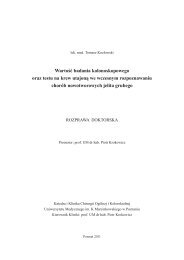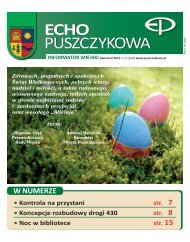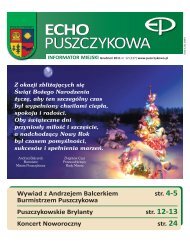© Military Pharmacy and Medicine • 2012 • 4 • 32 – 32equation y=axb). Regression equations and areasunder the curves of ketoprofen lysinate releaseexpressed in conventional units are listed in Table 5.As shown by the high correlation coefficient forthe linear equation y=ax+b at p=0.05, the processof release of ketoprofen lysinate from theointment follows a zero-order kinetics. The exactkinetic equations based on the analysis of the diffusionprocess are usually complex and have theform of a sum of exponential functions [16].The areas under the curves of release of the activesubstance from cholesterol derivatives-containingointments are larger than the area obtainedfor the ointment obtained from hydrophilic vaselineonly. For the cholesterol derivatives-containingointments, the values ranged from 0.5319 to0.9476, while for the M-0 ointment, the value was0.4044 c.u.Comparison of the areas under the curves of therelease of ketoprofen lysinate showed that theactive substance was best released from ointmentswith cholesterol oxyethylenates with thelowest n umber of segments (n TE ), regardless ofthe type of the catalyst used to produce theseReferences:1. Górecki M: Reologia farmaceutyczna - perspektywyrozwoju. Farm Pol, 1996; 52(16): 739-743.2. Górecki M, Zalewska A: Reometryczna analizafarmaceutycznych układów rozproszonych. Farm Pol,2000; 56(15): 748-752.3. Górecki M, Zalewska A: Reologia farmaceutyczna wanalizowaniu układów nienewtonowskich. Farm Pol,2001; 57(9): 417-419.4. Lee ChH, Moturi V, Lee Y: Thixotropic property inpharmaceutical formulations. J Control Release, 2009;136 (2): 88-98.5. Zgoda MM, Nachajski M, Kołodziejczyk M,Woskowicz M, Lukosek M.: Właściwościsolubilizacyjne i litogenolityczne wodnych roztworówniejonowych związków powierzchniowo aktywnychproduktów oksyetylenowania cholesterolu. PolimMed, 2007; 37(4): 39-57.6. Kołodziejczyk M., Zgoda MM: Oksyetylenowanycholesterol jako składnik modelowych płynówakceptorowych w ocenie dostępności farmaceutycznejliofilowych środków leczniczych. Farm Pol, 2007;63(8): 342-348.7. Kołodziejczyk M, Zgoda MM: Ocena właściwościfizykochemicznych produktów oksyetylenowaniacholesterolu w aspekcie micelarnej solubilizacjiliofilowych środków leczniczych. Pol J Cosmetol,2006; 9(4): 250-263.Original articleoxyethylenates (M-Ch-10 Na and M-Ch-10 Ca).More than a twofold increase in the efficacy ofrelease of ketoprofen lysinate was achieved fromointments containing cholesterol derivativesincluding n TE =10 oxyethylenic fragments.ConclusionsNovel formulae for the ointment base, obtainedafter introducing oxyethyleneated cholesterolderivatives into hydrophilic vaseline may comprisea potential vehiculum for anti-inflammatoryointments. Regardless of their chemical structure(the number of oxyethylenic fragments) and thetype of catalyst used in the synthesis of the oxyethyleneate,its presence in the ointment contributesto the favourable change in rheologicalparameters (increased surface area of extendedointment under pressure force, reduced structuralviscosity with a negligible effect on the effectof the water loss). Introduction of cholesterolderivatives into the hydrophilic vaseline-basedointments enhances the efficacy of the release ofketoprofen lysinate from the ointment. The highestareas under the release curved were obtainedfor products containing cholesterol derivativesfeaturing n=10 oxyethylenic fragments.8. Korzeniowska K, Jankowski J, Jabłecka A:Niesteroidowe leki przeciwzapalne. Farm Współcz,2010; 3: 192-197.9. Sarzi-Puttini P, Atzeni F, Lanata L, Bagnasco M,Colombo M, Fischer F, D'Imporzano M: Pain andketoprofen: What is its role in clinical practice.Reumatismo, 2010; 62(3): 172-178.10. Coaccioli S: Ketoprofen 2,5% gel: a clinical overview.Eur Rev Med Pharmacol Sci, 2011; 15(8): 943-949.11. Samczewska G, Zgoda MM: Solubilizacyjnewłaściwości wodnych roztworów siarczanuneomycyny. Pol J Cosmetol, 2002; 1: 49-63.12. Kołodziejska J: Parametry reologiczne past do zębów adostępność farmaceutyczna jonu fluorkowego. BromatChem Toksykol, 2004; 36 (1): 77-83.13. Zgoda MM., Ogiński M: Przydatność wybranychmembran dializacyjnych do oceny warunkach in vitroprocesu wymiany masy na granicy faz z preparatutypu hydrożel. Pol J Cosmetol, 1999; 3: 197-208.14. Tamburic S: The aging of polimer- stabilized creams:the rheological viewpoint. C&T, 2000; 115(10): 43-49.15. Poradnik fizykochemiczny, Wydawnictwo Naukowo-Techniczne, Warszawa 1974.16. Bodek KH: Badania porównawcze kinetykiuwalniania diklofenaku z hydrożelumikrokrystalicznego chitozanu i hydrofilowej maścifarmakopealnej. Farm Pol, 2000; 56 (15): 753-762.32 http://military.isl-journals.com
© Military Pharmacy and Medicine • 2012 • 4 • 33 – 50Jerzy Z. Nowak: Non-steroidal anti-inflammatory drugs (NSAIDs) in …OphthalmologyNon-steroidal anti-inflammatory drugs (NSAIDs) inophthalmology: pharmacological and clinical characteristicsJerzy Z. NowakDepartment of Pharmacology, Chair of Pharmacology and Clinical Pharmacology ofMedical University of Lodz, PolandAuthor’s address:Jerzy Z. Nowak, Department of Pharmacology, Medical University, ul. Żeligowskiego 7/9. 90-752 Łódź, Poland;phone: (+48) 42 6393290, e–mail: jerzy.nowak@umed.lodz.plReceived: 2012.10.28 • Accepted: 2012.11.22 • Published: 2012.12.08Summary:Non-steroidal anti-inflammatory drugs (NSAIDs) are widely used in the treatment of inflammation andpain of different origins. Although NSAIDs differ in their structures, their mechanism of action is similar.The therapeutic target of NSAIDs is cyclooxygenase (COX), occurring as two isoenzymes: COX-1(a constitutive enzyme) and COX-2 (an inducible enzyme, expressed in the course of the inflammatoryprocess). Being a component of prostaglandin H synthase (PGHS), COX catalyzes the first step oftransformations of arachidonic acids into prostaglandins (of the D, E and F series), prostacyclin (PGI2)and thromboxanes — all products characterized by diverse biological activities; some of them havingpro-inflammatory action, some being involved in pain mediation. The registered NSAIDs are a numerousfamily of drugs, with vast majority available as products for systemic use (per os, per rectum, intramuscularor intravenous injections) and external use (ointments); only a few products are intended forintraconjunctival administration (ophthalmic products). Active substances used in ophthalmic NSAIDsinclude indomethacin (the active substance in the first ophthalmic drug), suprofen (currently not used),flurbiprofen, pranoprofen, ketorolac, diclofenac, bromfenac and nepafenac. Ophthalmic NSAIDs currentlyavailable in Poland include: Indocollyre (indomethacin; at present rarely used drug), Dicloabak,Difadol 0,1% and Naclof (all containing diclofenac), Yellox (bromfenac) and Nevanac (nepafenac); thetwo latter compounds have only recently become available in Poland. Therapeutic indications may differslightly between individual drugs, but generally they include prevention and treatment of cystoid macularedema after cataract surgery, inhibition of intra-operative miosis during cataract surgery, reductionof pain and photophobia after refractive surgery, and, in addition, treatment of allergic conjunctivitis(mainly ketorolac-containing products). This article provides a critical review of NSAIDs used in medicaltherapy with particular focus on ophthalmic preparations.Key words: Non-steroidal anti-inflammatory drugs, NSAID, ophthalmic preparations,therapeutic indications.IntroductionNon-steroidal anti-inflammatory drugs (NSAID)are popular medications commonly prescribedby physicians and well known to patients. Manyhttp://military.isl-journals.comof such drugs are available without prescription,which contributes to the massive use of suchproducts as aspirin, ibuprofen and paracetamol— a drug closely related to the NSAID family,33
















